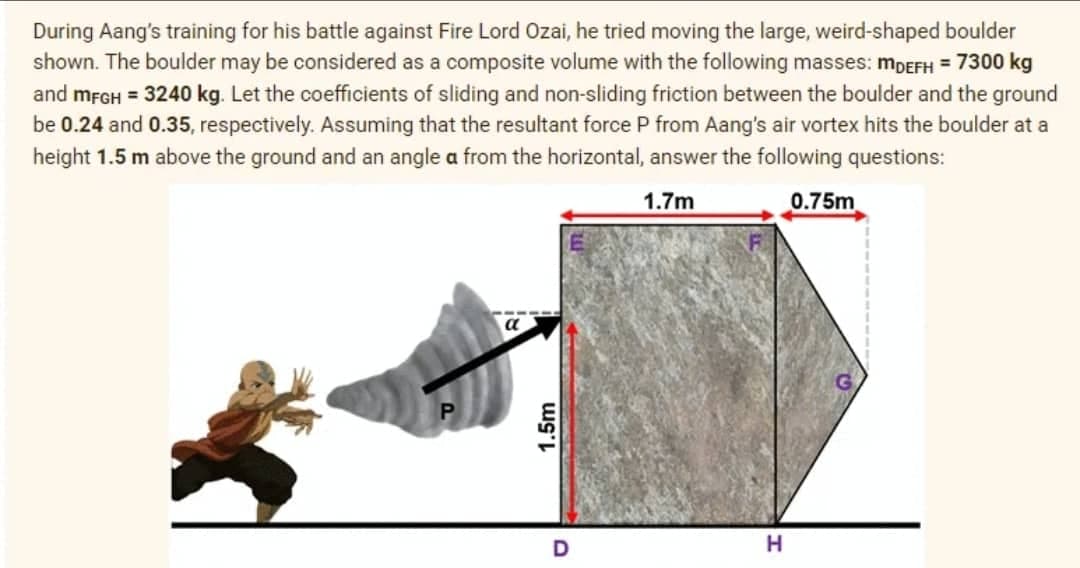During Aang's training for his battle against Fire Lord Ozai, he tried moving the large, weird-shaped boulder shown. The boulder may be considered as a composite volume with the following masses: mDEFH = 7300 kg and MFGH = 3240 kg. Let the coefficients of sliding and non-sliding friction between the boulder and the ground be 0.24 and 0.35, respectively. Assuming that the resultant force P from Aang's air vortex hits the boulder at a height 1.5 m above the ground and an angle a from the horizontal, answer the following questions: 1.7m 0.75m 1.5m
During Aang's training for his battle against Fire Lord Ozai, he tried moving the large, weird-shaped boulder shown. The boulder may be considered as a composite volume with the following masses: mDEFH = 7300 kg and MFGH = 3240 kg. Let the coefficients of sliding and non-sliding friction between the boulder and the ground be 0.24 and 0.35, respectively. Assuming that the resultant force P from Aang's air vortex hits the boulder at a height 1.5 m above the ground and an angle a from the horizontal, answer the following questions: 1.7m 0.75m 1.5m
Elements Of Electromagnetics
7th Edition
ISBN:9780190698614
Author:Sadiku, Matthew N. O.
Publisher:Sadiku, Matthew N. O.
ChapterMA: Math Assessment
Section: Chapter Questions
Problem 1.1MA
Related questions
Question

Transcribed Image Text:During Aang's training for his battle against Fire Lord Ozai, he tried moving the large, weird-shaped boulder
shown. The boulder may be considered as a composite volume with the following masses: mDEFH = 7300 kg
and MFGH = 3240 kg. Let the coefficients of sliding and non-sliding friction between the boulder and the ground
be 0.24 and 0.35, respectively. Assuming that the resultant force P from Aang's air vortex hits the boulder at a
height 1.5 m above the ground and an angle a from the horizontal, answer the following questions:
1.7m
0.75m
a
1.5m
H

Transcribed Image Text:3. If the angle a = 30°, what is the magnitude of the force P required for sliding to impend, assuming that there is no tipping?
●
34.8 KN
a = 30°, what is the magnitude of the force P required for tipping to impend, assuming that there is no slipping?
25.2 KN
52.4 KN
31.0 KN
Expert Solution
This question has been solved!
Explore an expertly crafted, step-by-step solution for a thorough understanding of key concepts.
Step by step
Solved in 3 steps with 3 images

Follow-up Questions
Read through expert solutions to related follow-up questions below.
Follow-up Question
If the angle a = 30°, what is the magnitude of the force P required for tipping to impend, assuming that there is no slipping?
Solution
Knowledge Booster
Learn more about
Need a deep-dive on the concept behind this application? Look no further. Learn more about this topic, mechanical-engineering and related others by exploring similar questions and additional content below.Recommended textbooks for you

Elements Of Electromagnetics
Mechanical Engineering
ISBN:
9780190698614
Author:
Sadiku, Matthew N. O.
Publisher:
Oxford University Press

Mechanics of Materials (10th Edition)
Mechanical Engineering
ISBN:
9780134319650
Author:
Russell C. Hibbeler
Publisher:
PEARSON

Thermodynamics: An Engineering Approach
Mechanical Engineering
ISBN:
9781259822674
Author:
Yunus A. Cengel Dr., Michael A. Boles
Publisher:
McGraw-Hill Education

Elements Of Electromagnetics
Mechanical Engineering
ISBN:
9780190698614
Author:
Sadiku, Matthew N. O.
Publisher:
Oxford University Press

Mechanics of Materials (10th Edition)
Mechanical Engineering
ISBN:
9780134319650
Author:
Russell C. Hibbeler
Publisher:
PEARSON

Thermodynamics: An Engineering Approach
Mechanical Engineering
ISBN:
9781259822674
Author:
Yunus A. Cengel Dr., Michael A. Boles
Publisher:
McGraw-Hill Education

Control Systems Engineering
Mechanical Engineering
ISBN:
9781118170519
Author:
Norman S. Nise
Publisher:
WILEY

Mechanics of Materials (MindTap Course List)
Mechanical Engineering
ISBN:
9781337093347
Author:
Barry J. Goodno, James M. Gere
Publisher:
Cengage Learning

Engineering Mechanics: Statics
Mechanical Engineering
ISBN:
9781118807330
Author:
James L. Meriam, L. G. Kraige, J. N. Bolton
Publisher:
WILEY